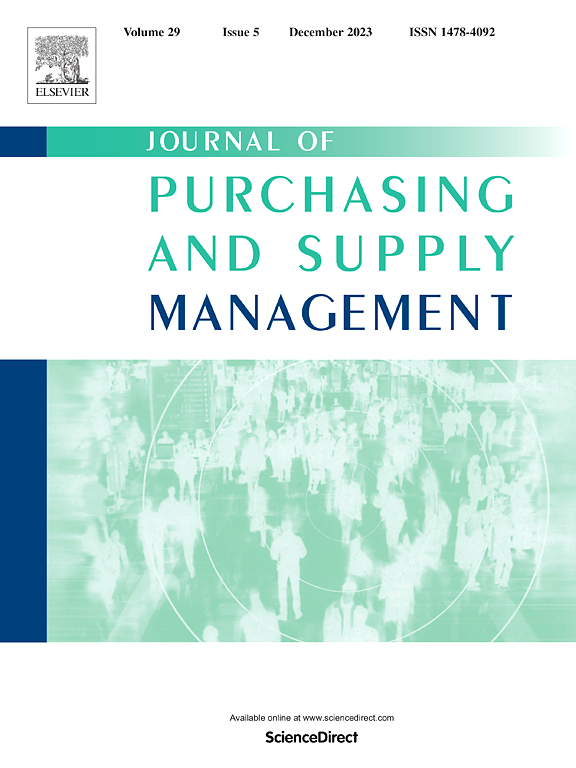勇敢的新采购交易:一项关于生成式人工智能如何重塑买方-供应商谈判的实验研究
IF 8.7
2区 管理学
Q1 MANAGEMENT
引用次数: 0
摘要
人工智能(AI)的技术突破正在影响买方与供应商的谈判,这种谈判越来越多地转向使用基于AI的聊天机器人进行人机谈判。虽然第一个人工智能谈判解决方案目前正在被采购专业人员用于非关键支出项目的谈判,这是结构性影响的一个例子,但基于人工智能的聊天机器人的行为影响(即对谈判方法的影响)仍然未知。目前尚不清楚这些聊天机器人在哪些行为设置中为购买公司带来了经济、心理和关系方面的价值。为了填补这一空白,我们在买方-供应商谈判环境中进行了三个实验,两个在实验室环境中与商科学生进行了实验,一个与专业谈判者进行了在线实验。在我们的交互式模拟中,参与者扮演供应商的角色,而基于chatgpt的定制训练聊天机器人扮演买家的角色。我们发现,与协作谈判方式相比,当聊天机器人采用竞争性谈判方式时,它将获得更高的价格折扣、更好的支付条件和更快的谈判速度。然而,与竞争提示相比,供应商更信任协作提示的聊天机器人,并表现出更高的结果满意度,以及对未来互动的更强烈愿望。对聊天互动的文本分析表明,当使用竞争性提示的聊天机器人时,相似度更高,这意味着供应商也使用更坚持和恐吓的语言,从而在更大程度上匹配聊天机器人的谈判方法。虽然谈判方式是一个重要的影响因素,但我们没有发现重要的证据表明物品类型(在我们的案例中是非关键或瓶颈)很重要,这表明基于人工智能的聊天机器人在各种买方-供应商设置中都是有效的。本文章由计算机程序翻译,如有差异,请以英文原文为准。
Brave new procurement deals: An experimental study of how generative artificial intelligence reshapes buyer–supplier negotiations
The technological breakthrough of artificial intelligence (AI) is impacting buyer-supplier negotiations, which are increasingly moving toward human-to-machine negotiations using AI-based chatbots. While the first AI-powered negotiation solutions are currently being used by procurement professionals to negotiate for non-critical spend items, which is an example of structural influence, the behavioral influence of AI-based chatbots (i.e., on negotiation approach) remains unknown. It is unclear in which behavioral settings these chatbots deliver value to the buying firm in terms of economic, psychological, and relational outcomes. To fill this gap, we conduct three experiments in buyer–supplier negotiation settings, two in a lab-setting with undergraduate business students and one online experiment with professional negotiators. In our interactive simulations, participants play the role of the supplier, while a ChatGPT-based custom-trained chatbot acts as the buyer. We find that when the chatbot deploys a competitive, as compared to a collaborative, negotiation approach, it will achieve a higher price discount, better payment terms, and a quicker negotiation. However, suppliers trust a collaboratively prompted, as compared to a competitively prompted, chatbot more and demonstrate higher outcome satisfaction, as well as a stronger desire for future interaction. A text analysis of the chat interactions indicates a higher level of similarity when a competitively prompted chatbot is employed, which implies that suppliers also use more insistent and intimidating language, thereby matching the chatbot's negotiation approach to a greater degree. While the negotiation approach is a significant influencing factor, we do not find significant evidence that item type, in our case non-critical or bottleneck, matters, which indicates that AI-based chatbots can be effective in various buyer–supplier settings.
求助全文
通过发布文献求助,成功后即可免费获取论文全文。
去求助
来源期刊

Journal of Purchasing and Supply Management
MANAGEMENT-
CiteScore
10.30
自引率
18.00%
发文量
31
审稿时长
70 days
期刊介绍:
The mission of the Journal of Purchasing & Supply Management is to publish original, high-quality research within the field of purchasing and supply management (PSM). Articles should have a significant impact on PSM theory and practice. The Journal ensures that high quality research is collected and disseminated widely to both academics and practitioners, and provides a forum for debate. It covers all subjects relating to the purchase and supply of goods and services in industry, commerce, local, national, and regional government, health and transportation.
 求助内容:
求助内容: 应助结果提醒方式:
应助结果提醒方式:


